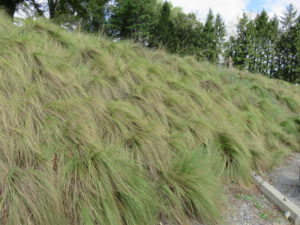Weeping Lovegrass (Eragrostis curvula) is a warm season, perennial bunchgrass. It grows to a height of 2-4 feet and the long narrow 1/4 inch wide leaves (10 to 20 inches in length) suggest the grass is “weeping”. Seed heads may be erect or drooping and produce small very numerous seeds (1.5 million per lb.). Weeping Lovegrass is easily established by seeds and spreads by tillering. Over a years time a single plant can colonize an area 12-15 inches in diameter. Lovegrass was first imported into the U.S. from South Africa in the late 1920’s.
Weeping Lovegrass grows best in the dryland agriculture of Texas, Oklahoma, Arizona, New Mexico, Nevada and California (east of mountains). Weeping lovegrass is also used along roadsides and for hillside stabilization in the Mid-Atlantic States. The species establishes rapidly, produces a deep rootsystem, a key feature for erosion control. Unlike its native cousin, purple lovegrass, weeping lovegrass is commercially available at reasonable cost.
Weeping lovegrass can be an aggressive competitor in ecosystems and is considered an invasive species in some states. It thrives on soils of low fertility. Fertilizer applications should be made in April for first seed crop and in August for second. Weeping lovegrass produces taller plants than purple lovegrass (E. spectabilis), but can still be considered a low-maintenance grass. The root system of weeping lovegrass is fibrous as well as deep and is utilized on steep embankments for erosion control.
It grows on almost any well-drained soil, but prefers the sandy loams. Lovegrass responds well to fertilization. Used for pasture (early spring / fall), hay, erosion control, and for steep bank areas throughout Western Plains and also used in transition zone of Eastern USA primarily for forage and erosion control.
Seeding Lovegrass: Weeping lovegrass is easy to establish from seed between May 1 and June 15. Seed are planted with small seed drill. At this time weed competition is less, seedling emergence is more uniform Rainfall is a lot less compared to early spring. Seed alone at a rate of 3 to 5 pounds per acre, or 1 to 2 pounds per acre in mixtures with other species. Fertilizer containing nitrogen (N), phosphorus (P), and Potassium (K) should be applied prior to seeding. A second N feeding may be applied in mid-summer.


 Posted in
Posted in 
